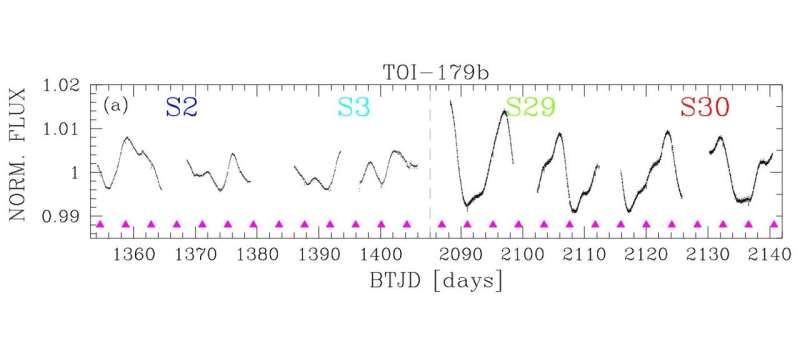
An international team of astronomers reports the detection of a new planetary system by observing a nearby star known as HD 18599 (or TOI-179). It appears that this star is orbited by a Neptune-mass exoplanet and a massive sub-stellar object. The finding was detailed in a paper published October 14 on the arXiv pre-print server.
TESS is conducting a survey of about 200,000 of the brightest stars near the sun with the aim of searching for transiting exoplanets. So far, it has identified nearly 6,000 candidate exoplanets (TESS Objects of Interest, or TOI), of which 266 have been confirmed so far.
Now, a group of astronomers led by Silvano Desidera of the Astronomical Observatory of Padova, has recently confirmed another TOI monitored by TESS. They report that a transit signal has been identified in the light curve of a bright K-dwarf star—TOI-179 (other designations HD 18599 and HIP 13754). The planetary nature of this signal was confirmed by follow-up observations using the High Accuracy Radial velocity Planet Searcher (HARPS) and Spectro-Polarimetric High-contrast Exoplanet REsearch (SPHERE) instruments.
“As part of on-going efforts to validate and characterize young transiting exoplanets identified by TESS, we present in this paper our analysis for the system observed around the star HD 18599 = HIP 13754, a bright (V=8.99 mag) and active K dwarf, also known as TESS Object of Interest (TOI)-179,” the researchers wrote in the paper.
The newfound alien world, designated TOI-179 b, is about 2.62 times larger than the Earth and 24 times more massive than our planet, which yields a relatively high mean density of some 7.4 g/cm3. The exoplanet orbits its host every 4.14 days, at a distance of 0.048 AU from it, on a significantly eccentric orbit.
Furthermore, SPHERE observations identified another object in the TOI-179 system with an estimated mass of about 83 Jupiter masses—therefore, at the boundary between brown dwarfs and very low-mass stars. The object received designation HD 18599 B has a relatively small projected separation from the parent star—some 3.3 AU.
The host star TOI-179 is of spectral type K2V, has a radius of approximately 0.76 solar radii, while its mass was measured to be 0.83 solar masses. The star is estimated to be around 400 million years old and its effective temperature is at a level of 5,145 K.
Summing up the results, the authors of the study underlined the uniqueness of the TOI-179 system taking into account the properties of its components.
“The TOI-179 system represents a high-merit laboratory for our understanding of the physical evolution of planets and other low-mass objects and of how the planet properties are influenced by dynamical effects and interactions with the parent star,” the researchers concluded.
© 2022 Science X Network













